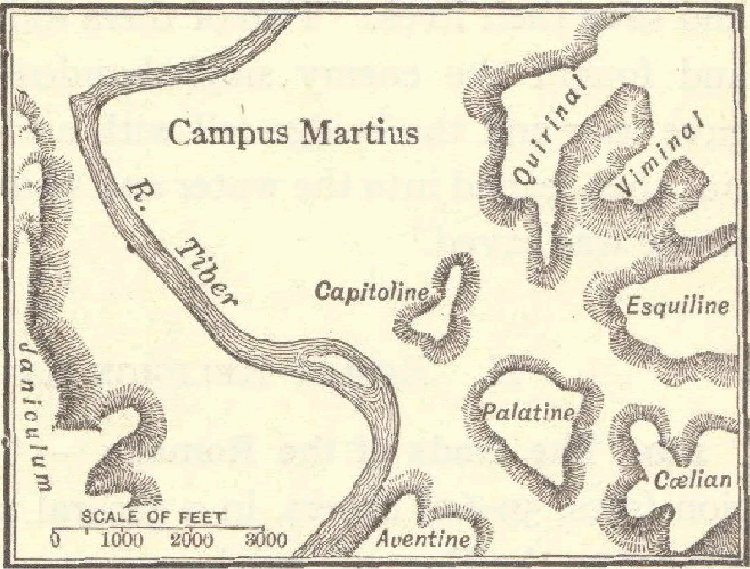| Seven Hills of Ancient Rome |
|---|
| www.studenthandouts.com ↣ World History ↣ Ancient Rome ↣ Ancient Rome Maps & Pictures |
 |
|
Map of the Seven Hills of Ancient Rome: (1) Quirinal; (2) Viminal; (3) Esquiline; (4) Palatine; (5) Coelian; (6) Capitoline; and (7) Aventine. Also Campus Martius, the River Tiber, and the Janiculum. Click here to enlarge this image.
The Seven Hills of Rome hold significant historical and symbolic importance in the foundation and early history of the city of Rome. According to tradition, Rome was built on these seven hills, and they played various roles in the city's development. Palatine: The Palatine Hill is one of the most famous of the seven hills and is often considered the center of ancient Rome. According to legend, this is where Romulus, one of the city's legendary founders, established his first settlement in 753 BCE. Over time, it became an aristocratic neighborhood, and the word palace itself is derived from "Palatine." Capitoline: The Capitoline Hill was home to the Temple of Jupiter Optimus Maximus, one of the most important temples in ancient Rome. It was a religious and political center and a key site for important state ceremonies. Aventine: The Aventine Hill was traditionally associated with plebeians, the common people of Rome. It was also known for the Temple of Ceres, an important deity for agriculture and fertility. Caelian: The Caelian Hill was mainly residential, known for its large villas and gardens. It was also the location of the Baths of Caracalla, one of the largest and most impressive public baths in ancient Rome. Esquiline: The Esquiline Hill was a diverse area with residential districts, but it was also associated with the lower classes and immigrants. It was home to the Baths of Titus and the Gardens of Maecenas. Viminal: The Viminal Hill was the smallest of the seven hills and had fewer significant monuments. It was mainly a residential area. Quirinal: The Quirinal Hill was also associated with residential neighborhoods and is known for the Quirinal Palace, which has served as a papal residence and the official residence of the President of the Italian Republic. These hills not only provided natural defensive advantages for early settlements but also influenced the city's urban layout, with various neighborhoods and functions associated with each hill. The Seven Hills of Rome are an important part of Roman mythology and history, and their significance is reflected in ancient Roman literature and culture. While the traditional story of Rome's foundation on the Palatine Hill by Romulus and Remus is a mixture of history and legend, the Seven Hills continue to be an enduring symbol of the eternal city of Rome. |
 |  |  |  |  |  |
| Ancient Rome Books and Films | Ancient Rome Outlines and PowerPoints |
| Ancient Rome Maps and Pictures | Ancient Rome Study Games |
| Ancient Rome Miscellany | Ancient Rome Worksheets |
| www.studenthandouts.com ↣ World History ↣ Ancient Rome ↣ Ancient Rome Maps & Pictures |








